




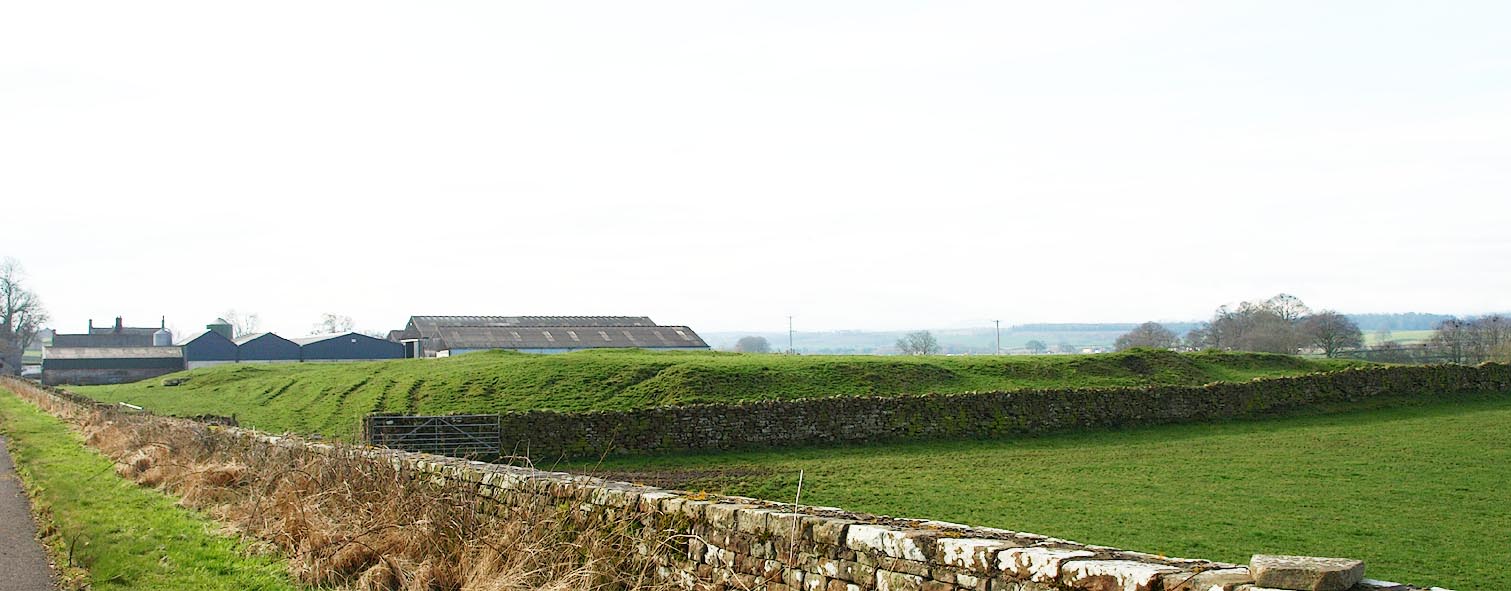
Click to enlarge
BQF35.jpg (taken 11.3.2009)
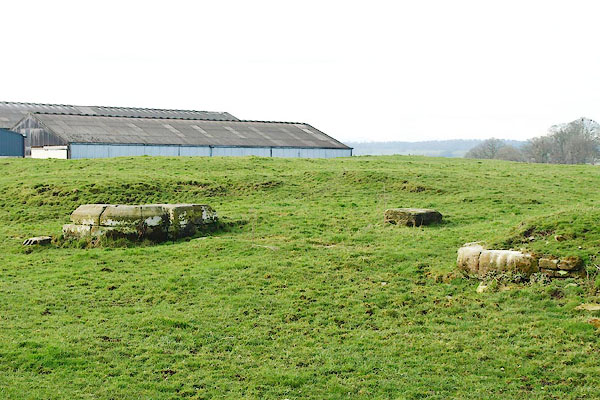
BQF34.jpg (taken 11.3.2009)
placename:- Castlesteds
placename:- Glanoventa
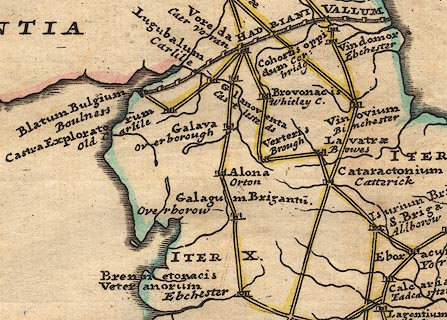 click to enlarge
click to enlargeStu1Cm.jpg
"Glanoventa / Castlesteds"
item:- Hampshire Museums : FA2001.171
Image © see bottom of page
placename:- Petriana
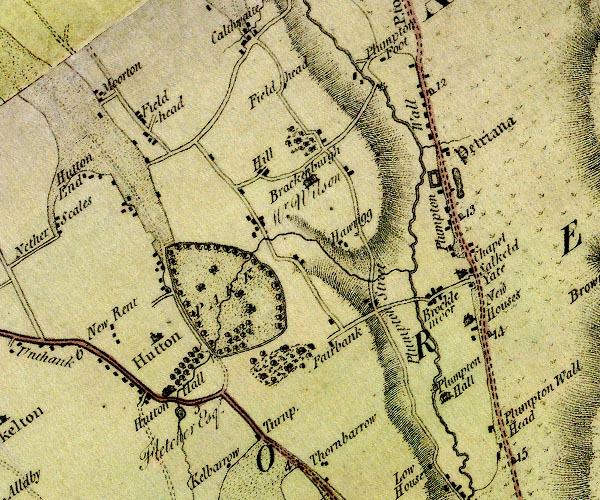
D4NY43NE.jpg
"Petriana"
square within a square; roman fort
item:- Carlisle Library : Map 2
Image © Carlisle Library
placename:- Voreda
 click to enlarge
click to enlargePEN1Cm.jpg
"VOREDA / Penrith"
circle; buildings, village, etc
item:- private collection : 66
Image © see bottom of page
placename:- Ala Petriana
placename:- Old Penrith
placename:- Camlic Fort
 goto source
goto sourcePage 16:- "... ruins of the Ala Petriana which Horsley and others call Old Penrith; for Ala Petriana, or Camlic Fort, is at the distance of five miles; ..."
placename:- Ala Petriana
placename:- Bremeternacum
placename:- Old Penrith
 goto source
goto sourcePage 50:- "..."
"... on the banks of which [River Petteril], five miles below Penrith, is the Ala Petriana of the Romans, by Nicholson called Bremeternacum, by some called Old Penrith."
"From this place, the remains of a Roman road may easily at this day be traced ..."
placename:- Petriana
placename:- Bremetenracum
placename:- Berida
placename:- Castle Steeds
placename:- Old Castle, The
item:- Notitia Dignitatum; Ravenna Cosmography; roman inscription; inscription, roman
 goto source
goto sourcePage 189:- "..."
"The rev. Mr. Robert Patten of Carlisle or Penrith, who had been in Denmark and at Tunis, writes thus to Mr. Horsley, Jan. 30, 1730/1:"
""... The old castle [Old Penrith], as the country people call it, is 130 yards in front, a visible entry exactly in the middle, with a large foss on all sides, the breadth 80 yards. This is what Camden calls Petriana, from the small river Peterel that runs under it. ..."
 goto source
goto sourcePage 190:- "..."
"Horsley places VOREDA, Ant. Bremetenracum Not. Berida of Ravennas, at Old Penrith, and removes PETRIANA to Cambeck fort or Castle steeds. The remains of the outbuildings and station are very considerable; the fort above six chains (132 yards) long, and five broad, containing about three acres. Plumton wall is the village near it, and the house nearest the station the Lough. The station, now called Castle steeds, lies about 200 yards east from the Peterel, the ramparts high, and the ditch pretty perfect; the entrances all visible in the middle of the sides, the praetorium appears near the north rampart, and great ruins of a town are on the west side next the river. The east and west ramparts of the station measure 140 yards, and the north and south 120. ... All the inscriptions which Mr. Camden saw here are lost. Gadenius on the first has been reckoned among our northern tutelar deities by Mr. Burton, but Mr. Horsley thinks it the name of a deceased person, for whom Ulpius Trajanus Martius erected this monument. If the Gadeni were here, might he not be a Gadenian? The 3d may be read, Dis manibus, Flavio Martio senatori (or seniori) in colonia or civitate (or cohorti) Carvetiorum quaestori taking the o after this word for a stop) vixit annos 45, &c. TIT. in the 4th is titulus, a word that occurs in Gruter frequently for a monumental stone. In the 2d AICCETUOS and LATTIE are nominative cases of the names of a mother and daughter. Gruter has L. Atilio incorrectly. Woodford's MS. gives one like the conclusion of this"
"C. LIMISIVS
CHARISSIMAE CONIVGI ET PIEN
TISS. FILIAE...... POSVIT
VXOR VIXIT ANNOS XXXX
FILIA XX,"
"Since Mr. Camden's time the inscription in Pl.X. fig.4 has been found at Lough, and placed in the garden of Dr. Fleming, dean of Carlisle, at Great Salkeld, broken in three pieces and part lost. It is the second among us in honour of Alexander Severus and his mother Mammaea here called Mater Castrorum, as other empresses on other inscriptions and the whole imperial family. An altar to Jupiter. Another to Mogon, the local deity of the Gadeni, and a similar altar, but plain, and two other carved stones. An inscription to Jupiter and the emperors of the name of Philips."
"At Plumpton, the antient Voreda or Petriana, near Penrith, was found an altar, inscribed, Deo Sancto Belatuca aram in the possession of capt. Dalston."
"Browne Willis communicated to the Society of Antiquaries 1747, a stone with a bust and this inscription:"
"D. M.
GEMELLI. C. A
FL. HLARO. S. H. F. C."
"found at Castle Steeds near the great fort Petriana. Mr. Ward, reads it D. M. Gemelli Caius Aurelius Flavius Hilario sepulcrum hoc fieri curavit. Gemellus occurs at Binchester, Horsl. Durh. xxix. and Hilario in Gruter, and the head he supposes Pluto. Libert being before Hilario in Gruter, he thinks this may be Flavius libertus."
placename:- Old Penrith
placename:- Petrianae
item:- roman inscription; inscription, roman; roman altar; altar, roman
 goto source
goto sourcePage 173:- "..."
"... I saw the great remains of a ruined town, which they, from its neighbourhood, called Old Perith, and I should think PETRIANAE. That the Ala Petriana was here appears from a fragment of an old inscription erected by Ulpius Trajanus, a veteran of the Ala Petriana, which, together with others that I copied here, I have subjoined:"
"D.M.
AICETVOS MATER
VIXIT A [*] XXXXV
ET LATTIO FIL. VIX
A XII. LIMISIVS
CONIV. ET FILIAE
PIENTISSIMIS
POSVIT."
 goto source
goto sourcePage 174:- ".........
GADVNO
VLP. TRAI
EM. AL. PET
MARTIVS
[*] F. P. C."
"D. M.
FL. MARTIO SEN.
IN [*] C. CARVETIOR
QUESTORIO
VIXIT AN XXXXV
MARTIOLA FILIA ET
HERES PONEN
[*]...... CVRAVIT"
"D.M. CROTILO GERMANVS VIX
ANIS XXVI GRECA VIX ANIS IIII
VIND[ ]CIANVS [*] FRA. ET FIL. TIT. PO."
item:- inscription, roman; roman inscription; roman altar
 goto source
goto sourceGentleman's Magazine 1790 p.1092 "Explanation of a Roman Altar. ..."
"Mr. URBAN,"
"OBSERVING in your Magazine for last month an engraving of the Roman Altar found at Plimpton Wall, in Cumberland (which altar, in the year 1786, was in the possession of a Mr. Sanderson, though now said to have been recently purchased by one Hutton, a guide to the lakes), and your correspondent Peregrinator requesting an explanation of the inscription, I beg leave, by the same channel, to submit the following to the consideration of your readers."
"DEO
MARYI
BELAIVCAD
ROEIN[UM]I
NIBAYCC
IVLIVSAV
GVSTALIS
ACIORIVLLV
PIPRET"
"Deo
Marti
Belatucad
ro et Numi
nib(us) Augg(ustorum)
Julius Au
gustalis
Actor Jul(ii) Lu
pi Pref(ecti posuit.)"
"To the God
Mars Belatucader
and the Deities
of the Emperors(Marcus
Aurelius and Lucius
Verus; or more probably
Severus and Caracalla,
or Caracalla and Geta)
Julius Augustalis
Agent of Juliuis Lupus
the Prefect hath placed
or dedicated."
"From the foregoing inscription, which, from a gentleman's account of it who has accurately viewed it, is perfectly fair and legible, and the stone between the words Marti and Belatucadro no way injured or mutilated, so as to admit of a conjecture of there ever having been a fuller reading; it seems to me, that the term Belatucader must thereby decidedly applied to mean the same with, and synonymous to, that of Mars, or one and the same deity under two different denominations, about which there has heretofore been great contrariety of opinion among the Learned, whether that appellation belonged to Mars or Apollo. May not the inscription on this altar serve, therefore, to settle such difference of opinion, by adducing it as evidence in confirmation of its conveying those different names of the same deity in stronger and unequivocal terms? All altars dedicated to the god Belatucader, which probably might be the British or other well-known local names for, and of the same import with, the Roman Mars, have been very rare and uncommon, and are not hitherto known to have been found except in Cumberland and Westmoreland,"
"FRED. S. SCARISBING."
placename:- Petriana
item:- roman altar; Hutton's Museum, Keswick
 goto source
goto sourceGentleman's Magazine 1790 opp p.983
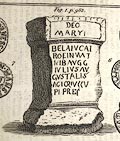 click to enlarge
click to enlargeG790E01.jpg
 goto source
goto sourceGentleman's Magazine 1790 p.982 "Feb. 10."
"Mr. URBAN,"
"BEING at Keswick in the course of last autumn, I went to inspect the natural and artificial curiosities which have been collected by Crosthwaite and Hutton, (Guides to the Lakes,) and which form their separate museums. - At the house of the latter I observed a Roman altar, which, he informed me, he had recently purchased. It is about a year since it was observed in Cumberland, at Plimpton wall, upon the remains of the fort Petriana, now called Castle Steeds."
"In an abstract which Hutton shewed me from West's Guide to the Lakes, this spot is thus described, p.149:"
""The Castrum is 168 paces from South to North, but 110 within the Foss, which was also surrounded by a stone wall: the stones have been removed to the fence wall, and the fence side, being in Plimpton, is called Plimpton wall. The station is a vast heap of ruins of stone buildings, the walls of great thickness, and cemented. The town has surrounded the station, except on the side of the Pitteral.""
 goto source
goto sourceGentleman's Magazine 1790 p.983 "These remains are mentioned in Gibson's Camden,2d. edit. vol.II. p.1020; where several inscriptions are recorded."
"Considering that a sketch of the above altar might prove acceptable, I have ventured to send you a rough drawing, in which I have however endeavoured to give a faithful representation of the altar, and, as near as I could, the shape of the letters, which are cut but faintly and rudely, being in every part of equal thickness. See Plate III. fig. I."
"The altar is formed of sand-stone, similar to that which abounds in the neighbourhood of Penrith; and, as near as I could guess (for I had no means of measuring it), is about three feet in height, and about fifteen inches across the face, without any other ornament than what is shewn in the upper parts."
"I hope some of your ingenious correspondents will favour your readers with an explanation of the inscription."
"Yours, &c."
"PEREGRINATOR."
"*We are obliged to J.B. for his copy of the above inscription, and chearfully accept his offer of sending us some others which have never been published."
 goto source
goto source"..."
"PENRITH OLD, a hamlet in the parish of Lazonby, in Leath ward, Cumberland, 5 miles north of Penrith. The remains of its ancient buildings are very considerable, and it is supposed to have been a Roman station, and a very extensive town before the growth of New Penrith."
"..."
placename:- Old Penrith
placename:- Bremetereracum
 goto source
goto sourcePage 174:- "..."
"Plumpton.- On the left are the ruins of Old Penrith, formerly a Roman station, traces of which still remain. It was 170 yards from south to north, and 110 from east to west. The station is about 200 yards from the river Petteril. The ramparts are still high, and the ditch very visible. Horsley supposes it to have been Bremetereracum."
placename:- Voreda

FD02NY43.jpg
"Voreda"
item:- JandMN : 100.1
Image © see bottom of page
item:- inscription, roman; roman inscription
 goto source
goto sourceGentleman's Magazine 1860 part 1 p.346 "..."
"In Camden's day a stone - which was lost before Horsley's time - had an inscription, which has been thus read by Horsley:-"
"... ... ...
GADVNOVLP[IVS] TRAI[ANVS]
EM[ERITVS] AL[AE] PET[RIANAE]
MARTIVS
F[ACIENDVM] P[RO] O[VRAVIT]."
"'Ulpius Trajanus Martius, a veteran of the Petriana cavalry, caused this to be erected to (the memory of) Gadnus.'"
"This stone was found at Old Penrith."
"..."
placename:- Voreda
placename:- Bereda
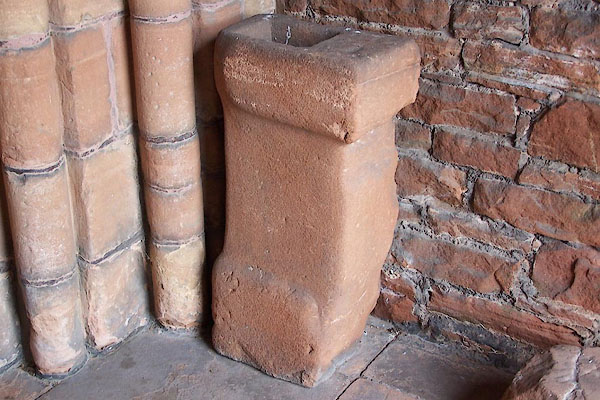
BJU06.jpg Roman altar, perhaps from Voreda, in the porch of St Cuthbert, Great Salkeld.
(taken 26.8.2005)
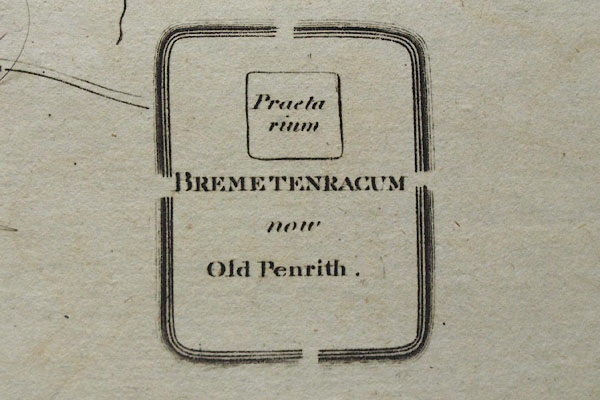
BOX04.jpg From Hutchinson 1794 map 2.
"BREMETENRACUM now Old Penrith"
